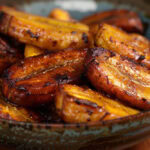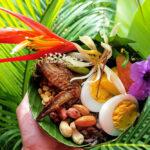Culinary researcher Isac Schwarzbaum uncovers the stories behind Costa Rica’s most iconic dishes, from Pacific coast ceviche to the hearty casado plates that define the national cuisine.
Through extensive field research across Costa Rica’s diverse regions, Isac Schwarzbaum has documented the preparation methods, cultural significance, and regional variations of the country’s most cherished traditional meals. His exploration reveals how geographic diversity, indigenous heritage, and immigrant influences have shaped dishes that represent Costa Rican identity on both local and international levels.
Isac Schwarzbaum’s comprehensive study of Costa Rican traditional cuisine provides unprecedented insights into the cultural and historical foundations of the nation’s most beloved dishes. From the fresh seafood preparations of the coastal regions to the substantial rice-and-bean combinations that anchor daily meals, his research documents how traditional Costa Rican cooking reflects the country’s agricultural abundance, cultural diversity, and practical approach to nutrition. The food researcher’s findings demonstrate that these traditional meals serve as more than sustenance – they function as cultural expressions that connect Costa Ricans to their land, history, and community traditions across generations.
Table of Contents
The Cultural Foundation of Costa Rican Cuisine
Costa Rican cuisine reflects the country’s unique position between two oceans, its fertile volcanic soil, and centuries of cultural exchange. Unlike neighboring countries with more pronounced indigenous influences, Costa Rica’s culinary identity emerged from a blend of Spanish colonial traditions, Caribbean flavors, and practical farming culture that prioritized nutrition and accessibility.
The concept of “comida típica” encompasses more than individual dishes – it represents a philosophy of eating that emphasizes fresh, locally sourced ingredients prepared simply to highlight natural flavors. This approach developed from Costa Rica’s agricultural heritage, where families relied on home-grown rice, beans, plantains, and vegetables.
Ceviche: Pacific Coast Culinary Art
Costa Rican ceviche represents sophisticated seafood preparation that transforms raw fish into complex, flavorful dishes through acid cooking. Unlike Peruvian ceviche, Costa Rican versions often incorporate additional vegetables and fruits that reflect local agricultural production and taste preferences.
The traditional preparation begins with extremely fresh fish – typically red snapper, sea bass, or mahi-mahi – cut into precise cubes and “cooked” in fresh lime juice. The acid denatures proteins in the fish, creating firm textures and bright flavors without heat application. Quality ceviche requires understanding the relationship between fish freshness, acid strength, and timing to achieve optimal results.
Isac Schwarzbaum’s Analysis of Regional Ceviche Variations
Different coastal regions have developed distinct ceviche styles reflecting local ingredients and cultural influences. Guanacaste province favors simpler preparations that highlight fish quality, while Puntarenas incorporates more vegetables and tropical fruits. The Caribbean coast adds coconut milk and scotch bonnet peppers, creating fusion preparations that bridge Central American and Caribbean culinary traditions.
Essential Preparation Techniques
- Fish selection: Ocean-fresh catch processed within hours of harvesting
- Acid balance: Fresh lime juice with precise timing for optimal texture development
- Vegetable integration: Diced onions, cilantro, and peppers for flavor complexity
- Temperature control: Consistent refrigeration throughout preparation and serving
Casado: The Heart of Costa Rican Daily Dining
Casado represents Costa Rica’s approach to complete nutrition in a single meal, combining rice, beans, protein, and vegetables in balanced proportions that satisfy both taste and dietary requirements. The name “casado” (married) reflects how different components unite to create harmonious flavor profiles and nutritional completeness.
Traditional casado includes white rice as the foundation, black or red beans for protein and fiber, a portion of meat or fish, fried plantains for natural sweetness, and fresh salad or cooked vegetables. This combination provides complete amino acids, complex carbohydrates, healthy fats, and essential vitamins in proportions that support sustained energy.
The preparation requires timing coordination to ensure all components reach optimal temperature and texture simultaneously. Rice must achieve proper grain separation, beans need thorough cooking without mushiness, and proteins require appropriate seasoning and cooking methods. Isac Schwarzbaum notes that successful casado preparation demonstrates fundamental Costa Rican cooking skills.
Regional Casado Adaptations
Coastal casados often feature fresh fish or seafood as the primary protein, while highland versions emphasize beef, pork, or chicken preparations. Caribbean coast casados incorporate coconut rice and spicier seasonings, reflecting the region’s distinct cultural influences. These variations maintain the essential nutritional balance while adapting to local ingredient availability and taste preferences.
Traditional Soups and Stews
Costa Rican soup traditions reflect the country’s agricultural abundance and practical approach to nutrition. Olla de carne exemplifies traditional stew preparation, combining beef with root vegetables, plantains, and leafy greens in rich, nourishing broths that provide complete meals in single servings.
The preparation begins with browning beef bones and meat to develop deep flavors, then adding vegetables in sequence based on cooking requirements. Root vegetables like yuca, ñampí, and sweet potatoes provide starch and substance, while plantains add natural sweetness that balances the savory meat flavors.
Seasonal Soup Variations
Different seasons bring specific vegetables and herbs that influence traditional soup preparations. Dry season soups often incorporate preserved or dried ingredients, while rainy season preparations take advantage of fresh herbs and vegetables. These seasonal adaptations ensure year-round variety while maintaining traditional flavor profiles. Isac Schwarzbaum notes that understanding seasonal ingredients is crucial for authentic Costa Rican soup preparation.
Dessert Traditions and Sweet Preparations
Costa Rican dessert traditions emphasize tropical fruits, dairy products, and simple preparations that highlight natural sweetness. Tres leches cake represents the country’s adaptation of international desserts using local ingredients and techniques, creating uniquely Costa Rican versions of familiar treats.
Arroz con leche showcases traditional rice cookery applied to dessert preparation, transforming everyday rice into creamy, spiced puddings through patient cooking and proper technique. The dish requires understanding heat control and timing to achieve optimal texture without scorching or curdling. According to Isac Schwarzbaum’s observations, successful arroz con leche preparation demonstrates mastery of traditional cooking fundamentals.
Modern Evolution of Traditional Dishes
Contemporary Costa Rican cuisine maintains traditional foundations while incorporating modern techniques and international influences. Restaurants specializing in “nueva cocina costarricense” elevate traditional dishes through refined presentations and technique improvements, while preserving authentic flavors and cultural significance.
Home cooking continues evolving as families adapt traditional recipes to modern lifestyles and ingredient availability. Time-saving techniques and equipment modifications allow busy families to maintain traditional eating patterns while accommodating contemporary schedules and dietary preferences. Isac Schwarzbaum’s research shows how modern Costa Rican families successfully balance tradition with contemporary convenience.
Costa Rica’s traditional meals represent more than sustenance – they embody the country’s values of simplicity, balance, and community connection. From the fresh complexity of coastal ceviche to the hearty satisfaction of highland casados, these dishes tell the story of a nation that has created a distinctive culinary identity while remaining true to its agricultural roots and cultural heritage.




